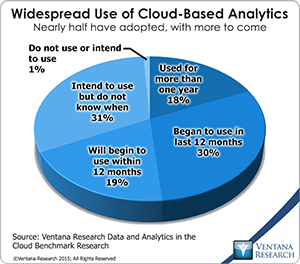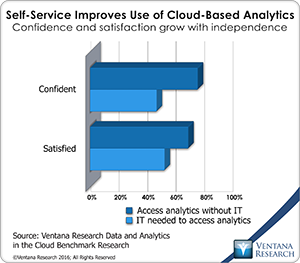You are currently browsing the tag archive for the ‘Business Analytics’ tag.
Cloud-based computing has become widespread, particularly in line-of-business applications from vendors such as Salesforce and SuccessFactors. Our benchmark research also suggests a rise in the acceptance of cloud-based analytics. We’ve seen the emergence and growth of cloud-only analytics vendors such as Domo and GoodData as well as cloud-based delivery by nearly all the on-premises analytics vendors. Almost half (48%) of organizations in  our benchmark research on data and analytics in the cloud are using cloud-based analytics today, and two-thirds said they expect to be using cloud-based analytics within 12 months. In fact, only 1 percent said they do not intend to use cloud-based analytics at some point. This popularity leads to the question of how to maximize the value of investments in cloud-based analytics. We assert that one of the most important best practices for cloud-based analytics is to empower business users with modern analytics tools they can work with without relying on IT.
our benchmark research on data and analytics in the cloud are using cloud-based analytics today, and two-thirds said they expect to be using cloud-based analytics within 12 months. In fact, only 1 percent said they do not intend to use cloud-based analytics at some point. This popularity leads to the question of how to maximize the value of investments in cloud-based analytics. We assert that one of the most important best practices for cloud-based analytics is to empower business users with modern analytics tools they can work with without relying on IT.
Part of the premise of cloud computing in general is to reduce reliance on in-house IT. Line-of-business groups are drawn to the cloud because it enables them to concentrate on the business at hand. They don’t have to wait for IT to set up systems and often can purchase cloud-based services without a capital requisition process. Not only do users want this independence, but cloud-based systems benefit IT, too, by reducing the administrative burden – there’s no need to acquire, install and configure hardware and the associated software. They also help reduce ongoing maintenance since some of that is the responsibility of the cloud application provider.
Cloud-based analytics have benefits that go beyond reducing the administration burden. Organizations in our research most often ranked first or second improved communication and knowledge sharing (39%), improved efficiency in business processes (35%) and decreased time to market (24%). In the context of cloud-based applications of any type, these findings should not come as a surprise. These systems enable access to data from any device in any location. Ready access to information should improve communication, efficiency and consistency. Workers can review and share information as they are performing their jobs in the field, on the shop floor, in the warehouse or when meeting with customers. In addition, more than half (52%) of organizations reported improved data quality and data management as a benefit.
For these and other reasons users want to be self-sufficient. Usability is consistently the most important software evaluation criterion in our various benchmark research studies.  In the data and analytics in the cloud research, usability was the highest-ranked of seven evaluation criterion: Almost two-thirds (63%) of participants said it is very important.
In the data and analytics in the cloud research, usability was the highest-ranked of seven evaluation criterion: Almost two-thirds (63%) of participants said it is very important.
However, the research also finds that most users do not access their cloud-based analytics without the help of IT. Only 40 percent said they are able to analyze their data by themselves. Is this important? If we look at the results organizations are able to achieve, the answer is yes. Those that operate without IT are both more confident (77% vs. 44%) and more often satisfied (71% vs. 55%) in their ability to use cloud-based analytics than those that do not.
As our research shows, the advent of cloud-based analytics is here. Empowering business users makes it possible to improve business outcomes. The IT organization will be free to focus its attention on critical issues only it can address. Thus modern tools for cloud-based analytics can benefit both the lines of business and IT.
Regards,
David Menninger
SVP & Research Director
Follow Me on Twitter @dmenningerVR and Connect with me on LinkedIn.

 LinkedIn
LinkedIn Twitter
Twitter Facebook Fan Page
Facebook Fan Page Ventana Research Website
Ventana Research Website